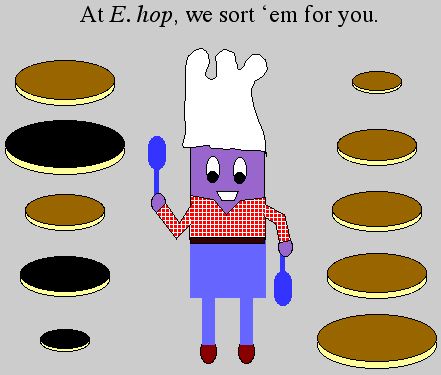Davidson 2006
From 2006.igem.org

Contents |
Students
• Sabriya Rosemond [1] is a rising junior biology major at Hampton University in VA.
• Erin Zwack [2] is a rising junior biology major at Davidson College in NC.
• Lance Harden [3] is a rising sophomore at Davidson College, who might major in math.
Faculty
• A. Malcolm Campbell [http://www.bio.davidson.edu/campbell Department of Biology], [4]
• Laurie J. Heyer [http://www.davidson.edu/math/heyer/ Department of Mathematics], [5]
Papers of Interest
• [http://www.bio.davidson.edu/courses/synthetic/papers/Sanders_04.pdf Stepwise Dissection of the Hin-catalyzed Recombination Reaction from Synapsis to Resolution. Erin R. Sanders and Reid C. Johnson]
• [http://www.molcells.org/home/journal/article_read.asp?volume=16&number=3&startpage=377 The Effects of Ethidium Bromide and Mg++ Ion on Strand Exchange in the Hin-mediated Inversion Reaction. Hee Jung Lee et al.] Excellent description of Hin recombination mechanism.
• [http://www.jbc.org/cgi/reprint/267/16/11183 The Effects of Symmetrical Recombination Site hixC on Hin Recombinase Function. Heon Man Lim et al.]
• [http://www.pubmedcentral.gov/articlerender.fcgi?tool=pubmed&pubmedid=3457367 The role of the loxP spacer region in P1 site-specific recombination. Ronald H.Hoess et al.]
• [http://www.biomedcentral.com/1471-2164/7/73 A high-throughput screen identifying sequence and promiscuity characteristics of the loxP spacer region in Cre-mediated recombination. Perseus I Missirlis et al.]
• [http://nar.oxfordjournals.org/cgi/content/full/30/13/2764 Non-contact positions impose site selectivity on Cre recombinase. Andreas W. Rufer and Brian Sauer]
• [http://www.pubmedcentral.nih.gov/articlerender.fcgi?artid=103771 Growth Phase-Dependent Variation in Protein Composition of the Escherichia coli Nucleoid]
Project Description

General Questions
• What is our team name and project name?
• ERIC What is HU?Answer1
• KELLY What is the recombinase enhancer (RE; function, sequence, usual position, relationship with HU, etc.)?
• KELLY What sort of spacing can RE allow and still work?
• KELLY Will we need more than one RE to accomplish recombination at all positions?
• TREVOR What is FIS? Answer1a
Math Questions
- What is the problem we are solving?
- Can we determine more than just Even/Odd number of flips?
- What is the distribution of the number of flips required, if each flip is random?
- What designs might allow us to track flips made?
- Can we model the distance of RE from pancake vs. time or number of flips
- Can we model the kinetics of n flips?
- Is it possible to simulate the impact of one-time flipping lox/hix sites?
- Help us design the fewest number of constructs that will allow us to scale up the number of flips in our constructs (1, 2, 3, 4...n)
Biology Questions
• ERIN How can we turn Hin off quickly (using CRE or mutating HIX so that they stop after one reversal)?
• B-RAD Do we want to be able to turn Hin on and off more than once?AnswerS
• Should we create a transgenic E. coli with Hin and/or Cre in the chromosome so we won't need so many plasmids?
• How can we count the number of Flips? (even vs. odd only?)
• SABRIYA Does CRE flip once and is then done with that pancake, or will it be excised the next time?
• ERIC How many flips would the normal negative supercoiling of a plasmid in E. coli allow?
• B-RAD Can we alter the amount of negative supercoiling and thus the number of flips if necessary?AnswerA
• What happens to supercoiling if we make the plasmid larger?
• What happens to supercoiling during the stationary phase, relax?
• T-ODD (the biologist formerly known as EckDizzle) Can we apply EtBr to relax the number of supercoils and thus stop recombination?Answer T1
• What should we use as the reporters? Fluorescent vs. Resistant pancake or combinations?
• Possible detection delays for both methods and how to minimize the delays
• How can we gradually scale up the number of flips with the fewest number of constructs?
• ADAM Can we use mutated lox or hix sites that will allow only single flips?
When core sequences are mismatched on the HIN-H107Y mutant, ligation is prevented but synapsis and cleavage is allowed. After recombination, the sites with different core sequences create DNA knots due to "inability to base-pair at crossover site after single exchange of DNA. A second exchange that restores the parental sequence of the recombination sties, but ties a knot in the plasmid DNA, is required for ligation." This would be a possible way to allow for a series of flipping sites to be side by side and keep them from interacting with each other. This question is still unanswered, but interesting info found along the way.
• T-ODD Will a segment flip multiple times or will the enzymes move to new sites? Answer T2
Assembly Issues
• What is the list of DNA parts that we will need for the first stage, second stage, entire project?
• Which DNA parts exist in the registry?
• Which DNA parts will have to be designed? Will they be synthesized or produced by PCR?
• Which plasmids will be used from the registry?
• Where would biobricks be located?
• MALCOLM What is the protocol for assembly for the first stage (restriction digestions, ligations, transformations)?
- http://www.bio.davidson.edu/courses/Molbio/Protocols/reagents.html Common molecular reagents
- [[http://www.bio.davidson.edu/courses/Molbio/Protocols/magnesium.html PCR and Mg2+ concentration]]
- http://www.bio.davidson.edu/courses/Molbio/Protocols/pourgel.html Pouring an agarose gel
- http://www.bio.davidson.edu/courses/Molbio/Protocols/molwt.html Calculate MWs
- http://www.bio.davidson.edu/courses/Molbio/Protocols/digestion.html Digest DNA with restriction enzymes
- http://www.bio.davidson.edu/courses/Molbio/Protocols/gels2002/1kbladder.pdf 1kb MW markers
- Shrimp alkaline phosphatase URL to come
- Ligation URL to come
- Transformation URL to come
- Promega miniprep URL to come
Here's what we'd like to see on your wiki page(s):
- A list of all team members, their roles, and email addresses
- Overview of project(s), including schematics and figures
- Ongoing data/updates about project(s), including schematics, figures, test data, and biobrick parts used
- Some photos of your team, facilities, institution, etc.
- Optionally, anything that broadcasts your team's personality, spirit, sense of fun, or coolness...